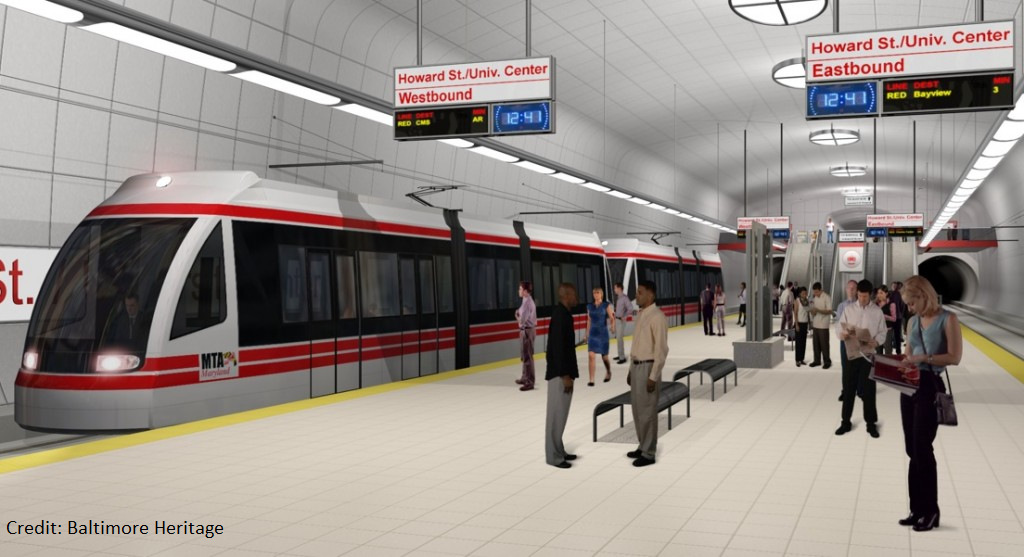By: Edmund Weisberg, Maryland Sierra Club
Baltimore, MD
Donald Trump’s unhinged, racist, inaccurate potshots at Rep. Elijah Cummings put Baltimore in the national news in late July. Both city and congressman received plenty of verbal support but Baltimore and its surroundings need more than words. Building the essential Red Line, that was quashed by Governor Hogan in 2015 would be a significant step towards restoring Baltimore’s economy while addressing the real issues taken out of context by Mr. Trump.
Hogan’s tragic decision to cancel the Red Line translated to the disappearance of $900 million promised by the federal government for this much needed public works project. Unfortunately, the longer it takes for a renewed commitment to build the Red Line, the more the project will cost. Obtaining federal funds for the project will also depend on supportive presidential and gubernatorial administrations. That’s why we endorsed a bill in the General Assembly this winter to study the creation of a Regional Transit Authority that could provide a necessary funding mechanism for local projects such as the Red Line.
Baltimore still lives in the shadow of its sordid history of racially based transportation and housing discrimination, known as redlining, dating to the 1950s that still plagues the city today. It is difficult to escape the effects of concentrated poverty in a city with haphazard, unreliable, ineffective public transportation. How can people be expected to obtain or keep a job without reliable transportation? Hogan’s decision to derail the Red Line also had disproportionate racial effects, with people of color comprising the majority of people using public transportation in and around Baltimore.
The city’s feckless public transportation system puts our community at an economic and social disadvantage compared to the transportation options available in other East Coast cities. As the Baltimore Transit Equity Coalition, which is leading the fight to resurrect the Red Line, says, “Central Maryland can recover from the loss of the Red Line Rail Project – by building it.”
The proposed 14.2 mile Red Line, planned to run from Bayview in the east to Woodlawn/CMS in the west would feature 19 stations and travel the corridor in 45 minutes. One third of the course would operate underground. Originally projected to open in October 2019 and attract 54,000 weekday riders by 2030, the Red Line was estimated to cost $2.9 billion in 2015.
In addition to mitigating the social and economic damage imposed by Baltimore’s history of racial discrimination, building the Red Line would provide an immediate economic boost from 10,000 construction jobs and represent a shift toward environmental justice by providing sustainable transportation options to a population now lacking them.
The infrastructural backbone rendered by the Red Line would promote economic growth around the line’s 19 rail stops, impacting neighborhoods such as Canton, Brewers Hill, Greektown, and Poppleton. With a Red Line in operation, thousands of regional residents would enjoy greatly enhanced access to important centers of commerce, education, and recreation, such as:
-
Centers for Medicare, Medicaid
-
Social Security Administration
-
Enoch Pratt Free Library, Rec Centers
-
Shopping Malls, Business Centers
-
Camden Yards
-
University of Maryland and Connection to MARC Penn Line
-
Baltimore Financial District
-
Harborplace
-
Fells Point
-
Johns Hopkins Bayview Medical Center
-
Patterson High School
-
Amazon Warehouse
Baltimore, like any community, benefits when the barriers that could divide us are transformed into bridges that unite us. Just as a house divided cannot stand, so an atomized city, disunited and separated without strong connecting fibers, will flounder and fail. The Red Line would help to bridge Baltimore’s many neighborhoods while providing residents without cars or who would like to drive less more convenient access to jobs and schools. As a cleaner, healthier, and climate friendly mode of transportation, the Red Line would represent a substantial, concrete step toward transforming the rhetoric and goals of the Green New Deal into a Baltimore regional reality. The Maryland Sierra Club strongly supports bringing the Red Line to fruition for a healthier, more vibrant Baltimore.
